方針・ビジョン
環境ビジョン2050
エプソンは将来にわたって追求していくありたい姿として、「持続可能でこころ豊かな社会を実現する」ことを明文化しました。ありたい姿の実現には、社会が抱える課題に向き合い、今までのやり方を抜本的に変える「変革」を起こさなければ、この目標に到達できないと私たちは考えます。
実現できる/できないの視点ではなく、エプソンが「ものづくり企業としてやり遂げなければならないこと」を描いたのが環境ビジョン2050です。
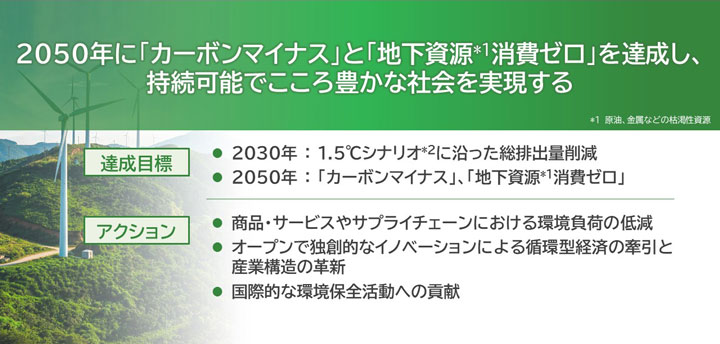
*1 原油、金属などの枯渇性資源
*2 SBTイニシアチブ(Science Based Targets initiative)のクライテリアに基づく科学的な知見と整合した温室効果ガスの削減目標
エプソンは、 2008年に2050年をゴールとした「環境ビジョン2050」を策定し、その実現に向け環境活動を展開してきました。その後国連で採択された、持続可能な開発目標(SDGs*3)や、脱炭素社会を目指すパリ協定*4など国際的に持続可能な社会に向けた動きが加速するなどの環境変化を受け、策定から10年後の2018年にステートメントを見直し、進めるべき3つのアクションを定めました。
そして、2021年3月には、脱炭素と資源循環という大きな社会課題に対するエプソンの強い意志を示す具体的な達成目標を設定するなど、さらなる改定を行いました。
*3 2015年9月の国連サミットで採択された持続可能な社会に向け、気候変動や貧困、人権など世界が抱える問題に対して取り組む国際目標。
17の目標と169のターゲットからなる。
*4 世界の平均気温の上昇幅を産業革命前から2℃未満に十分に抑えるという世界共通の長期目標などを定めた気候変動問題に関する国際条約。
TOPICS
カーボンバジェット
IPCC*5によると、地球温暖化による気温上昇は、温室効果ガス(GHG)の累積排出量と比例関係にあることが明らかになっています。気温上昇をある水準までに抑えるためには、GHGの累積排出量(過去の排出量と将来の排出量の合計)に上限が設けられており、この上限値は「カーボンバジェット(炭素予算)」と呼ばれています。
最新のIPCC第6次評価報告書 統合報告書(2023年3月公表)によると、2020年時点で、気温上昇を1.5℃に抑えるために残されたカーボンバジェットは約5,000億トン(50%の確率)とされています。当時の排出ペースのままでは、この残量はおよそ10年で使い切ってしまうと見込まれていました。
しかし、2020年以降、世界の年間GHG排出量は減少するどころかむしろ増加傾向にあり、累積排出量を制限して1.5℃目標を達成することは、ますます困難な課題となっています。
*5 国連気候変動に関する政府間パネル
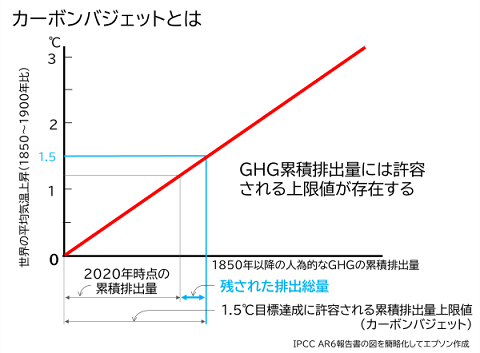
関連情報
自然資本
自然資本をベースとした企業活動の考え方
私たちが利用する資源は自然資本と呼ばれ、「地下資源」「非生物フロー」「生態系資本」で構成されます。
地下資源の採掘は生物圏の破壊につながります。また、採掘した資源を工業製品として使用する際には、多くのエネルギーを消費し、CO2を排出します。
エプソンは自然資本の使い方を抜本的に変えていきます。地上に掘り出した地下資源を「地上資源」として活用することで新たな地下資源消費を減らし、非生物フローを今後のエネルギー源として利用します。生態系資本は使いすぎることなく適切な使い方をすれば枯渇することのない資本です。
自然界においては、太陽エネルギーのみをエネルギー源とし、廃棄物を生むことなく、全ての物質が循環しています。「廃棄物を出さない」自然の姿を謙虚に学び、資源を繰り返し利用する事業活動を目指します。
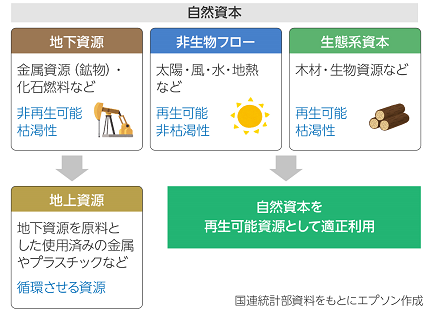
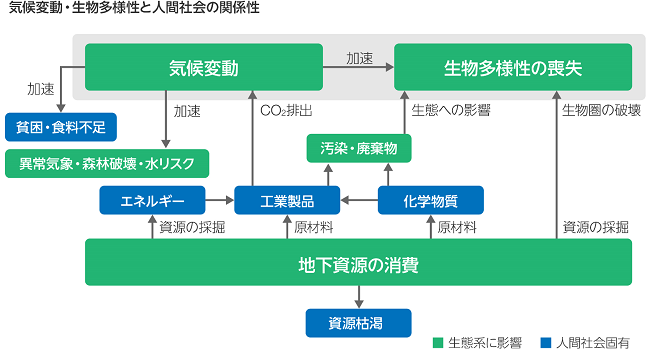
関連情報
アプローチ
脱炭素の取り組み
2015年に採択したパリ協定の発効により、低炭素化から脱炭素化へと、産業や経済などあらゆる市場の状況が変化しました。
気候変動枠組条約におけるパリ協定は、それまでの京都議定書とは異なり、世界の平均気温上昇を産業革命前から2度より十分低く保つことを決め、21世紀後半にはGHGネットゼロを実現する必要性を示しました。その後2018年にIPCCが「1.5℃特別報告書」を発表し、1.5℃と2℃上昇では、例えば熱波や洪水による影響に明確な違いがあるとわかり、気候危機克服への1.5℃目標の必要性が世界で認識され、その目標達成への動きが広まっています。
世界が協力して化石燃料の消費をゼロにし、大気からCO2を除去するという、「ネットゼロ」に向けて社会システムを移行する必要があります。
1.5℃と2℃の場合の影響比較
| 1.5℃ | 2℃ | |
|---|---|---|
| 熱波に見舞われる世界人口 (少なくとも5年に1回) |
約14% | 約37% (約17億人増加) |
| 洪水リスクにさらされる世界人口 (1976年~2005年比) |
2倍 | 2.7倍 |
| 2100年までの海面上昇 (1986~2005年比) |
26~77cm | 1.5℃に比べてさらに10cm高い 影響を受ける人口は最大1千万人増加 |
| 生物種 | 昆虫の6%、植物の8%、脊椎動物の4%の種の生息域が半減 | 昆虫の18%、植物の16%、脊椎動物の8%の種の生息域が半減 |
| サンゴ | 生息域70~90%減少 | 生息域99%減少 |
| 北極(夏場の海氷が消失する頻度) | 100年に1度 | 少なくとも10年に1度 |
| 海洋の年間漁獲高 | 150万トン減少 | 300万トン以上減少 |
出典:IPCC SR1.5 SPM & Chapter 3にもとづくWWFジャパン作成資料
脱炭素の目指す姿:カーボンマイナス
事業活動に起因する全ての温室効果ガス(GHGスコープ1、2、3)の排出を限界まで絞り込み、残ったGHGに相当するCO2を大気中から取り除いて実質的にGHG排出ゼロとし、さらに上回る除去を行った状態をカーボンマイナスと定義し、その達成を目指します。
まず、生産に関わるエネルギーと、商品に関わるエネルギーについて、徹底的なエネルギー削減を進め、使用するエネルギーを再生可能エネルギーへと転換します。資源循環はGHG削減にも効果的であり、地下資源消費ゼロの目標とともに、GHGを排出させないものづくりを進めます。
エプソンは環境負荷を小さくした商品を提供し、お客様に使っていただくことで、お客様のもとでのGHG削減を進めています。この削減量を削減貢献量と定義し、その量を増やすものづくりにも同時に取り組んでいきます。
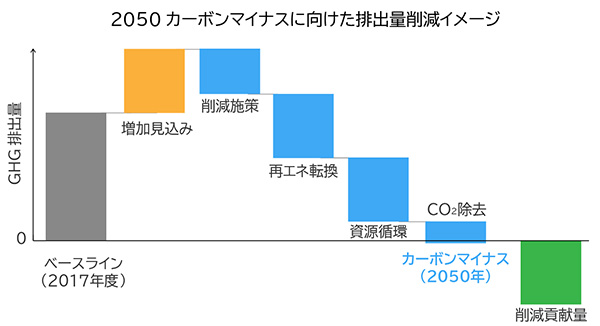
資源循環の取り組み
大量生産・大量消費、あるいは大量廃棄の一方通行の「線形経済」(Linear Economy)に代わる、持続可能性をもたせる経済の仕組みとして、「循環型経済」(Circular Economy)の考え方が提唱されています。欧州では、欧州委員会がサーキュラー・エコノミー・パッケージを採用し、資源をより持続可能な形で使用する循環型の経済への移行に向けて、具体的な取り組みを開始しています。
また、OECD(経済協力開発機構)*1のレポート*2では、人口増加やGDPの成長に伴い、2060年の世界の資源消費を、 2011年の79ギガトンの2倍以上に当たる、167ギガトンになると予測しています。
*1 Organisation for Economic Co-operation and Development。欧州諸国を中心に日・米を含め35ヶ国の先進国が加盟する国際機関
*2 Global Material Resources Outlook to 2060

資源循環の目指す姿:地下資源消費ゼロ
エプソンは、地上に掘り出した地下資源を「地上資源」として活用することで新たな地下資源消費を減らし、2050年までに地下資源消費ゼロとする事業活動を作りあげます。
投入する資源の総量を減らし、捨てるものをなくし、サステナブル資源の利用率*1を100%にすることにより、地下資源消費ゼロの達成を目指します。
*1 原材料に対するサステナブル資源(再生可能資源+循環資源+低枯渇性資源)の比率。

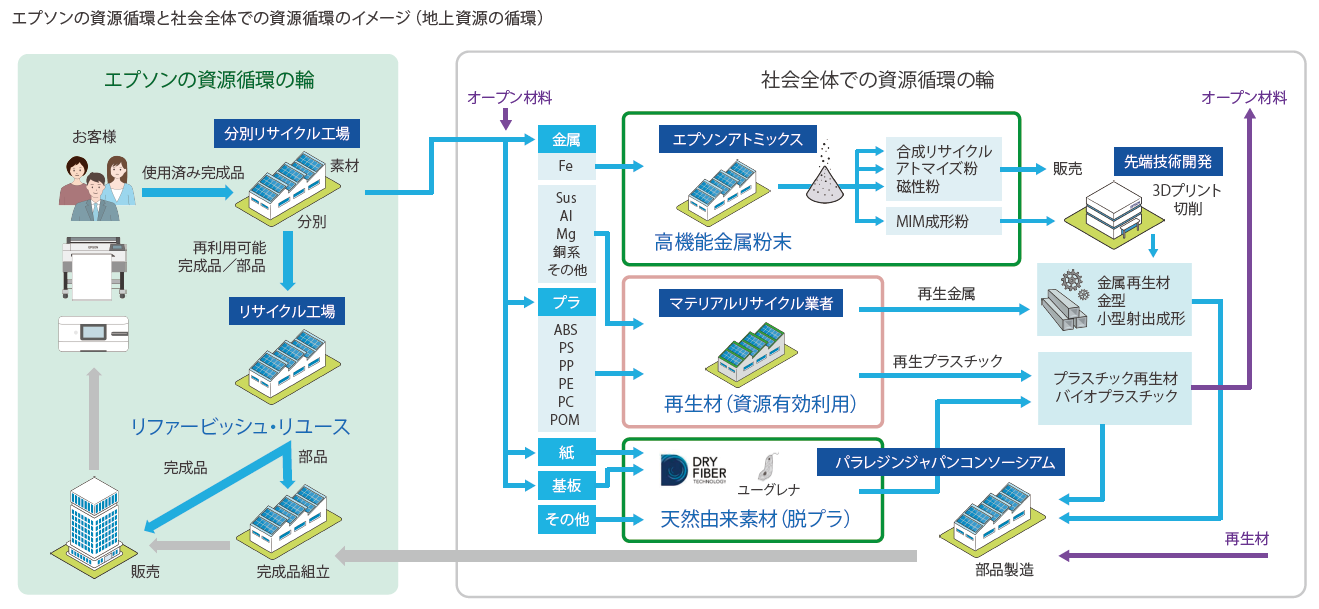
関連情報
グリーンボンドの発行
持続可能な社会の実現に向けて求められる活動は地球規模におよび、一企業の事業活動における環境負荷の低減で貢献できることは限られます。そこで「環境ビジョン2050」には、エプソンのテクノロジーや商品・サービスを基盤にさまざまなパートナーとシナジーを創り出し、より良い社会のためその役割を果たすことをアクションとして明記しています。
「環境ビジョン2050」を実現するため、マイルストーンとして中間目標を置き、現実とのギャップを埋めながら着実な取り組みを行っています。ものづくり企業として「省・小・精」を究め極めた独創の技術と取り組みにより、商品の環境性能向上や事業活動など、バリューチェーンを通じた環境負荷低減を進めていきます。また、商品・サービスを通じて、従来とは異なる新たな業務プロセスをお客様に提案し、環境と経済を両立する高いお客様価値の提供を目指します。
このような方針のもと、エプソンは、環境問題の解決に資する事業の資金を調達するために、国内公募形式によるグリーンボンド*1を発行しました。なお、エプソンが発行するグリーンボンドは、第三者評価機関によるセカンドパーティ・オピニオンを取得し、国際資本市場協会(ICMA)が公表するグリーンボンド原則2018および環境省グリーンボンドガイドライン2017年版の要件を満たします。
ロードマップ
2050年までにカーボンニュートラルを超えたカーボンマイナス、さらに地下資源の消費ゼロを掲げ取り組みを進めています。 長期的な目標からバックキャスティング*1して、中期的にどのように進むのか具体的なシナリオを描いたものが、「中期環境活動計画」です。事業成長に伴い、サプライチェーンにおけるGHG排出量や資源使用量は増加します。そこで環境戦略と事業戦略を両立させた「環境価値創出シナリオ」を全事業で策定し、2050年目標達成のロードマップを展開していきます。
*1 あるべき姿、ありたい姿としてのビジョンをまず描き、次にそこへ至るためのシナリオを検討する手法。
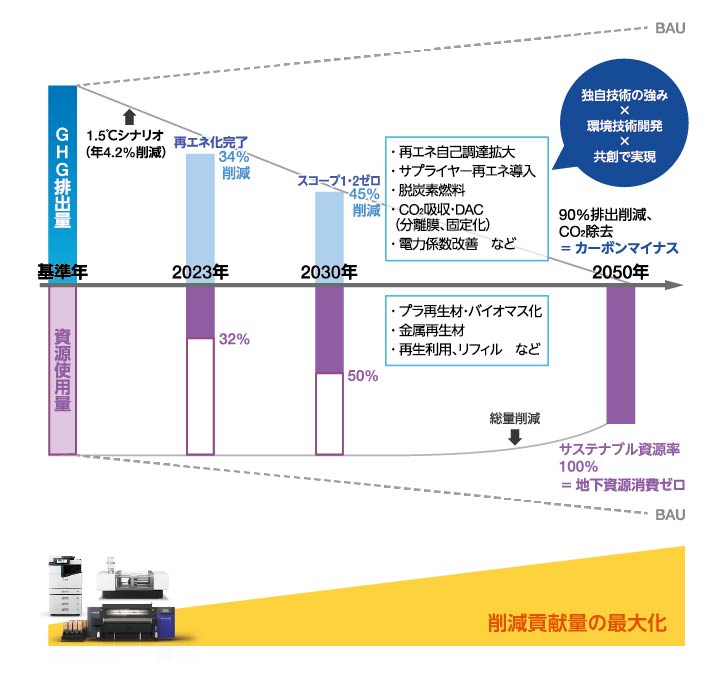
中期環境活動計画の内容(ジャンル別目標・主な施策)
| 脱炭素 |
【2030年目標】 ・スコープ1、2排出量ゼロ*1 ・スコープ1、2、3総排出量55%削減(2017年度比) 【主な施策】 ・設備の電化、脱炭素燃料転換(スコープ1削減) ・使用電力の再エネ化、地域・自社の発電拡大(スコープ2削減) |
|---|---|
| 資源循環 |
【2030年目標】 サステナブル資源率50% 【主な施策】 主要材料(プラスチック・金属)のサステナブル資源化 |
| 共通 |
【主な施策】 ・商品小型・軽量化、消耗品・交換部品の削減 ・商品省エネ化 ・戻入品再販売、使用済み製品再整備、リフィル ・長期使用ビジネスモデル化 ・サプライヤーエンゲージメント(再エネ・再生材) ・生産ロス極小化、温暖化物質削減 |
| お客様のもとでの環境負荷低減 |
【主な施策】 社会の環境負荷低減に資する製品・サービスの拡大 |
*1 2017年比でスコープ1、2排出量を90%削減したうえで、残余排出量に対して中和を行い実質排出量ゼロとする。
「環境ビジョン2050」と企業ビジョン
持続可能な社会の実現に向けて求められる活動は地球規模におよぶため、一企業の事業活動における環境負荷の低減だけで貢献できることは限られます。そこで「環境ビジョン2050」には、エプソンのテクノロジーや商品・サービスを基盤に、さまざまなパートナーとシナジーを創り出し、より良い社会のために役割を果たすことをアクションとして明記しています。
2021年3月には、社会課題を起点として、お客様やパートナーの皆様と共に課題解決に取り組み、持続可能でこころ豊かな社会の実現を目指していくことをありたい姿として長期ビジョン「Epson 25 Renewed」を策定しています。
エプソンが創業以来培ってきた「省・小・精の技術」は、環境負荷の低減や高い生産性に寄与するインクジェット技術を生み出すなど、今後もさまざまな社会課題の解決に貢献し、 SDGs(持続可能な開発目標)の実現にも大きな役割を果たしえると自負しています。この強みを生かし、さまざまなパートナーとの共創の下、環境と経済を両立する高いお客様価値の提供を目指します。
長期ビジョン Epson 25 Renewed 環境

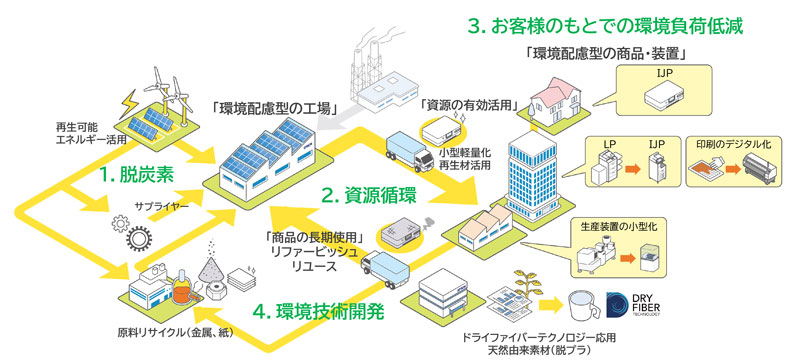
| 1.脱炭素 | · 再生可能エネルギー活用 · 設備の省エネ · 温室効果ガス除去 · サプライヤーエンゲージメント · 脱炭素ロジスティクス |
|---|---|
| 2.資源循環 | · 資源の有効活用: 小型軽量化/再生材活用 · 生産ロス極小化 · 製品の長期使用: リファービッシュ/リユース |
| 3.お客様のもとでの環境負荷低減 | · 低消費電力化 · 長寿命化 · 消耗品・交換部品の削減 · 印刷のデジタル化 · 生産装置の小型化 |
| 4.環境技術開発 | · ドライファイバーテクノロジー応用 · 天然由来素材(脱プラ) · 原料リサイクル(金属、紙) · CO2吸収技術 |
環境投資・費用
- 2030年までの10年間で1,000億円を投入(1、2、4項)
- サプライチェーンにおけるGHG排出量*1を200万トン以上削減
- 2023年には、エプソングループ全体の消費電力*2の100%を、再生可能エネルギー化(2023年12月に完了)
- 環境負荷低減に貢献する商品・サービスの開発に経営資源を集中(3項)
*1 GHGスコープ1、2、3排出量。
*2 一部、販売拠点などの電力量が特定できない賃借物件は除く。
関連情報
持続可能な社会の実現に向けて
エプソンは、環境活動を含むCSR活動を通じて、SDGsの達成に貢献することを宣言しています。
SDGsとは、全ての人がより良い生活を送ることができる世界を目指し、そのために世界中の人々が取り組むべき目標です。例えば、貧困や飢餓を終わらせること、人権や平和、ジェンダーの平等が守られること、そして地球環境や天然資源を未来の世代のために持続させることなど、17の目標を掲げ、国連に加盟する全ての国が、その達成を目指し、2030 年に向けて取り組んでいくものです。
エプソンの「環境ビジョン2050」は、2030年の世界の目標であるSDGsと方向性は同じです。SDGsの達成を目指しながら、持続可能な社会の実現に向け、常にお客様や社会の課題に真摯に向き合い、事業活動を通じてエプソンならではの環境価値を創出し続けます。
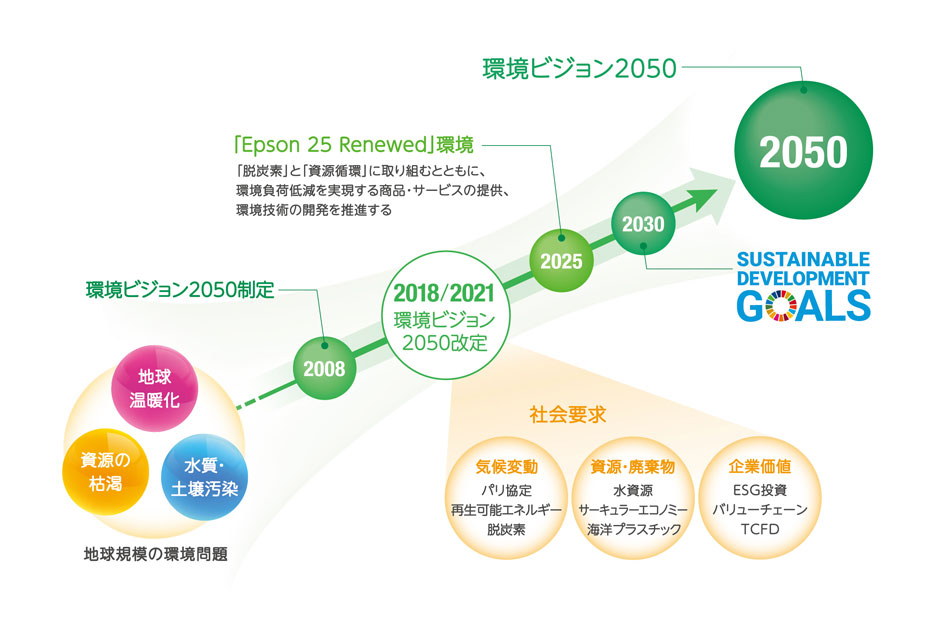
インクジェット技術による社会課題の解決
持続可能な社会実現のため、「インクジェットで世の中を変えたい」という想いのもと、インクジェット技術による(プリンティング)イノベーションを進めています。
詳しくはこちらをご覧ください。



